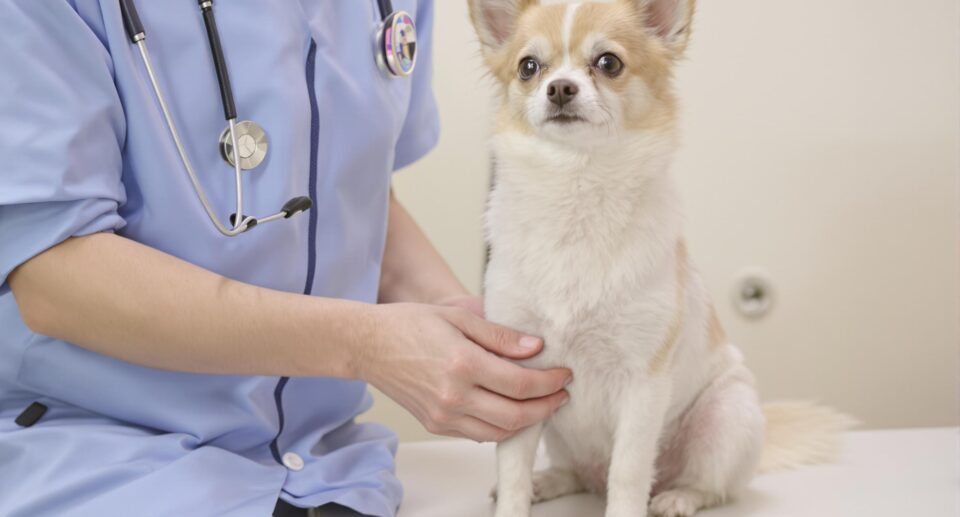What is Luxating Patella or Kneecap Dislocation in Dogs?

Does your pet sometimes run with a little skip in their step, or hold up one hind paw for a few strides, then continue running as though nothing has happened? Luxating patella, also known as kneecap dislocation or a “trick knee,” is the most common orthopedic issue in small and toy breed dogs, diagnosed in about 7% of puppies. It’s also occasionally seen in cats and large dogs, too.
What Is Luxating Patella?
The “patella” is your pet’s kneecap, and it normally rests in a groove at the end of their femur, or thighbone. It’s not attached to the bone, rather, it’s held in place by a ligament that runs up the femur. The kneecap allows the joint to move smoothly, somewhat like a pulley system, when your pet extends their leg.
In pets with a luxating patella, the knee ligament is offset slightly. When the pet extends their leg, the kneecap shifts. Both knees are affected in about 50% of cases.
Medial luxating patella, most commonly seen in small dogs and cats, causes the kneecap to move inwards, towards the center of the body.
Lateral luxating patella causes the kneecap to move outwards, away from the body, and this condition is usually seen in large breed dogs.
Over time, this abnormal movement can cause the groove in which the kneecap sits can wear down and become more shallow. As a result, the kneecap is more likely to move out of place and less likely to return to its normal position.
What Causes Luxating Patella in Pets?
Luxating patella is primarily a congenital condition that your pet can inherit from their parents. It’s present at birth and often diagnosed by the time your pet is six months old, though it may go undetected until it begins to cause symptoms, which may not happen until your pet is a young adult.
Toy breed dogs, including the Chihuahua, Yorkie, Pomeranian, Maltese, and Bichon Frise are most likely to eventually develop some level of patellar luxation. Certain large breeds, including the Shar-Pei, Great Pyrenees, Flat-Coated Retriever, and Akita are also genetically predisposed to luxating patella.
In cats, Devon Rex and Abyssinian breeds are most likely to be affected. Reputable dog and cat breeders have their breeding stock tested for luxating patella to avoid having puppies or kittens predisposed to developing the condition.
Less often, luxating patella is not present at birth, instead associated with trauma or injury that may weaken the bone or soft tissue that supports the knee.
Symptoms of Luxating Patella in Pets
It’s possible for a dog or cat with luxating patella to experience few to zero symptoms for years. Aging, obesity, or injury can exacerbate the condition and lead to noticeable progression. Patellar luxation is classified according to four grades of severity.
Grade 1
- Rare or occasional “skipping” or hopping with one hind leg up
- Luxation is brief and typically resolves itself
- Kneecap can be moved manually by a vet
Grade 2
- Kneecap frequently pops out on its own
- Pet can learn to extend and rotate leg to regain function
- Kneecap can be moved in or out manually by a vet
Grade 3
- Kneecap is out of place more often than not
- Can be moved back manually
- May shift weight to front legs, noticeable change in gait
- May avoid using affected leg
- Pet may appear bow-legged or hunched over
Grade 4
- Kneecap is permanently displaced
- Pet is unable to straighten leg
- Significant loss of mobility
Diagnosis and Treatment of Luxating Patella in Pets
Your veterinarian can diagnose luxating patella during a physical examination. They may also use x-rays or a CT scan to get a better look at the structure of the bone and surrounding tissue.
In dogs and cats with Grade 1 or 2, treatment may not be necessary, though your veterinarian may recommend avoiding exercises and movements that can trigger luxation, like running, sudden turns, and jumping.
Grade 3 or 4 luxating patella is corrected through surgery to move the knee ligament and/or deepen the groove in the femur. Without treatment, pets with a luxating patella are more susceptible to developing arthritis or a cranial cruciate tear. Surgery is successful in the great majority of cases and most pets regain full use of their knee after recovery
VISION
Every pet deserves to live a long, happy, healthy life.





